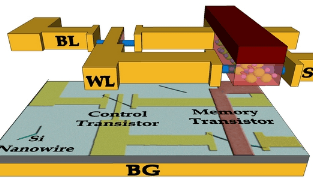Radically new memory technology
on

Researchers at Purdue University (USA) are developing a new type of computer memory that could be faster than the existing memory devices and consume far less power than flash memory. The devices combines silicon nanowires with a ferroelectric polymer, which is a material that switches polarity when an electric field is applied, to make storage cells whose polarity can be read as digital ones and zeros.
The new technology, which according to the researchers is still in a very nascent stage, is called FeTRAM for “ferroelectric transistor random access memory”. FeTRAM devices are nonvolatile, which means that data is retained in the absence of power. They could potentially use only 1% of the power of current flash memory devices, although the current version consume more power because it is not properly scaled.
On of the main development objectives for future generations of FeTRAM will be to reduce power dissipation. The researchers also think that the devices could ultimately be faster than SRAM. The new technology is compatible with fabrication processes for CMOS devices.
FeTRAM is similar to ferroelectric random access memory (FeRAM), but unlike FeRAM the new technology allows nondestructive readout because data is stored in a ferroelectric transistor instead of a capacitor.
This work was supported by the Nanotechnology Research Initiative through Purdue's Network for Computational Nanotechnology, which is supported by National Science Foundation. Findings are detailed in a research paper published recently in Nano Letters.
Image: Birck Nanotechnology Center, Purdue University


Discussion (0 comments)